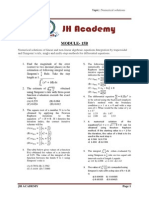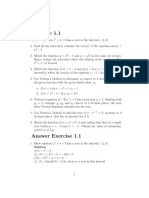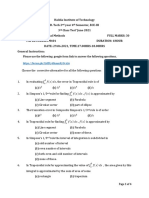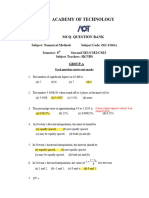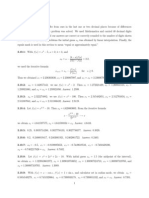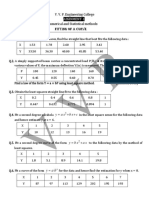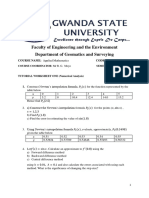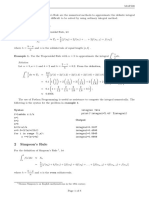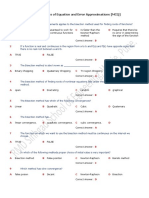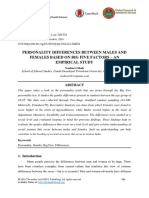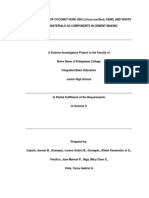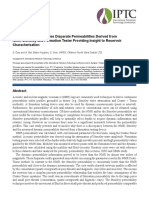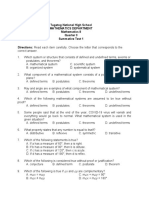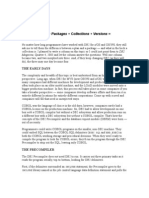Numerical Methods WB
Uploaded by
BHAGIRATH MEENANumerical Methods WB
Uploaded by
BHAGIRATH MEENAEngineering Mathematics
Numerical Methods
The Newton-Raphson method is used to solve Raphson iterative method. For an initial guess
Q.1
f(x) = 0, where f(«) = e - 5x.
If the initial guess 0)= 1.0, the value of the
Copyright: of r= 2.500 m, the revised estimate of rafter
one iteration is
three decimal places).
m (rounded off to
next iterate, 1), rounded off to 2 decimal
places, is
Subject [CH, GATE-2022]
[CH, GATE-2024] materto
Q.5 Let x² - 117 = 0. The iterative steps for the
solution using Newton-Raphson's method is
o2 The Newton-Raphson algorithm for the function MADE given by
f(x) =-a will be EASY
(a) *k+1 =x7 t
(b) **+=|x +2
Publicatons,
New
(b) k+1= X7
117
(c) X7 +1= k
(C) k+1= 2x7 axk
Delhi. 117
No
part (d) *k+1 =X7 [GATE]
(d) xk+1 = X* [GATE] of
this
Q.6 To solve the equation 2 sin x = x, by Newton
Q.3 The following equation needs to be numerically bo k Raphson method, the initial guess value is
solved using the Newton-Raphson method. may chosen to bex = 2. Consider x in radians only.
x+ 4x-9 = 0 be
The value of x (in radians) obtained after one
The iterative equation for this purpose is
(k indicates the iteration level)
(a) x7+1=
2x+9
repoduce
or
iteration will be closest to:
(a) 8.101
(c) 2.099
(b) 1.901
(d) 12.101
3x + 4 utilsed
in
[PI, GATE-2016]
9
3x + 4 any Q.7 Consider the series xn+1=t Xo = 0.5
(b) X7 +1= 2 8x,
2x +9 form obtained from the Newton-Raphson method.
(C) Xk+1=X-3x + 4 without
the
The series converges to [GATE)
4x+3 Q.8 Starting with x= 1, the solution of the equation
(d) X* +1=
9x +2 [GATE] writen x+ X = 1, after two iterations of Newton
Q.4 Ihe area of a circular field is 25 m2. The radius,
(, is to be determined using the Newton
permison. Raphson's method (up to two decimal places)
is [GATE 2017]
o Copyright : mBOE ERSS
Publications www.madeeasypublications.org
4 8 E n g i n e e r i n g M a t h e m a t i c s
mADE
method is
to be
used to
find
y)dx, using lrapezoidal Puble
©SCuopbyjreigcht;
initial
=0. If the
rule
ddecimal place) i
Newton-Raphson
Q9 3 - e +sinr
0.333,
the (Rounded off to 1
equation as
foot of roots is
taken
be 0
of the root
would
lrail value for the 2
next
a p p r o x i m a t i o n
|Y() 3 A
(CE, GATE-2016) 6
IPI, GATE-2024 :2
mater
equation
solution of the
numerical r/2
Q.10 A obtained using to Q.14 For theintegral
can be
f(a) = x+
Vr-3=0
method. If the
starting value
that is to MADE percentage error in (8+4cosx)dx abso he
the value of.r
lrule, numerical
Newton-Raphson
the Trapezoidal
only evaluaion
iteration.
isr = 2 for the
next step IS EASY (round offusing
be used in the to one the end
(b) 0.739
decimal po,
Publicatons,
(a) 0.306
(c) 1.694
(d) 2.306
[EC, GATE-2011] Q.15 The integral [ME, GATE-20%pla:
1
f(x) has values of
Q.11 A 2nd degree polynomial,
respectively. The New -412. +3x +2\dx
1and 2,
1,4 and 15 at x= 0.
is estimated
integral [(:) dt is to be estimated by
applying
No
p
numerically using three
methods namely the
What is the and Simpson's rules rectangular, alternabi
the
rule to this data.
trapezoidal
approximate
part In with a
this Context, which common steptrapezoi da
"true value - of size
error (defined as statement is TRUE? one of the
value") in the
estimate? this (a) Simpson's
rule as well as
fol owing
4
2
(b) bo k of estimation
will rectangular nia
(a) 3
may (b) Only Simpson's give non zero error.
2 zero error.
rule of estimation will oue
[GATE]
(c) 0 ber (c) Simpson's rule,
rectangular
trapezoidal rule of estimationrulewillasaivewellas
non.
Q.12 The integral (dr with x, > x > 0 is zero error.
(d) Only the rectangular rule of estimation wil
evaluated analytically as wel as numerically given zero error.
using a single application of the trapezoidal [CE, GATE-2020)
rule. If I is the exact value of the integral sed i
4
obtained analytically and Jis the approximate
value obtained using the trapezoidal rule, which
Q.16 The value of Je'd by Simpson's rule is (n =4)
of the following statements is correct about
(a) 53.87 (b) 53.60
their relationship?
(c) 54.29 (d) None
(a) J> I
used to estimate
(b) J < I Q.17 Simpson's one-third rule is
(c) J = I the definite integral
(d) Insufficient data to determine the relationship wperimtesn 1-[1-d
Which one of the
[GATE] lenath of 0.5.
With an
interval
cORRECT
estimate of /
Q.13 The values of function x) at discrete values following is the
of x are given in the table. The value of obtained using this rule?
wwmadeeasypublications
o Copyright : mADE EASY
Publcatices
ImROE E R s Y
ERSY
WOrKb0OK 49
-Publications
1 1 2 (a) 1.3 (b) 1.5
(a) 3
1
3
(b) a 3 ©
(c) 1.7 (d) 1.9
(c) 3 3
1
(d)
1
3 3
[CH, GATE-2023]
Copyright: [EE, ESE-2020]
Q.23 Consider the first order initial value problem
y=y + 2X- x², y(O) = 1, (0sx< o
integral
1.4
xxdx
Subject with exact solution y(x) = x² + ex, For x= 0.1,
the percentage difference between the exact
no evaluation of thedefinite -1 mat er solution and the solution obtained using a single
Simpson's 1/3rd (one-third) rule with to iteration of the second-order Runge-Kutta
hy using
yields method with step-size h 0. 1 is
step
(a) 0.592
ssize h = 0.6
(b) 0.581 MADE [GATE-2016]
(c) 0.914
(d) 1.248
[ME, GATE-202o]
EASY du
= 3t +1 withu=0
Q.24 Consider the equation
Publicatons,
dt
1 at t= 0. This is numerically solved by using
's rule is used to integrate the the forward Euler method with a step size.
S i m p s o n
3
Q. 19 At= 2. The absolute error in the solution in the
3
between x=0 andx=1 New end of the first time step is
Aunction f(*)=
using the
least number of equal sub-intervals.
integral is
Delhi. [GATE 2017]
the No Q.25 Runge-Kutta fourth order method is used to
The value of
[ME, GATE-2015] part dy
of solve differential equation = y- x. If the
dx
method is used to solve
Q.20
The Euler's thís initial value yO) = 2 and step size is 0.1, then
value of y0.1) is (upto three decimal
dy = xy- 4, yO) = 1
dx
bo k place).
The step size is 0.1. The approximate value may [PI, GATE-2017]
(round off to 2 decimal be
of y(0. 1) is
places). Q.26 The value of
0.21 Consider an ordinary differential equation
dx = 4t+ 4. Ifx =X, at t= 0, the increnent in x
[PI, GATE-2023]
repoduce
or
A°[(1-ar)(1- br°)(1-c)(1- d**)]
is
(a) abcd (10!) (b) abcd (9!)
dt
calculated using Runge-Kutta fourth order multi
utilsed
in
(c) abcd (8!) (d) abcd (7!)
[ESE Prelims-2020]
step method with a step size of At = 0.2 is any Q.27 Consider the data of f(x) givern in the table.
(a) 0.22
(c) 0.66
(b) 0.44 form
(d) 0.88 1 2
[ME, GATE-2014] without 1
f(x,)00.30100.4771
3
Q.22 Using Runae's formula of order 2, when x = the
1.1, given dy = 3x +
dx
and y= 1.2 when
writen The value of f(1.5) estimated using second
**1, taking h = 0.1. The value of y will be
nearly permison. order Newton's interpolation formula is
(rounded off to 2 decimal places).
[CE, GATE-2024]
Copyright mADE ERSy
Publications ) www.madeeasypublications.org
50 Engineering Mathematics mRDE ER
Publica
T2. A numerical solution of
Q.28 If y= 2r3-32 +3r - 10, the value of 4y will
be f(x) = X+x-3=0 can the equa
be
Newton-Raphson method. If theobtained
(where, Ais forward differences operator)
(a) 10
(c) 12
(b) 11
(d) 13
Copyright: IS X=2for the starting
y
iteration, the value of xtht:
[EE, ESE-2019]
Q.29 Thestraight line that wil best fit for the following
Subject T3.
be used in the next step is
[Ans: (1.8:,
data: m
x, =24, Ey, =24, 2x-130, 2xy,=113.2 and 6
at er to
Newton-Raphson method is used to com:
a root of the equation x* - 13 = 0 with 2:
the initial value. The approximation after.
n=6 is
(a) y= 0.72 + 1.33x MADE iteration is
[Ans: (3.6
(b) y= 1.976 + 0.506x
(c) y= 1.42 - 1.07x
EASY T4. Newton-Raphson interaction formula for fin
the root of an equation f(x) =0 is
(d) y= 1.33 + 0.72x
Try Yourself
Publicatons,
New
[Ans: n+1= Xn f
Delhi.
Solutions to Non-linear egquations No
x'+ 4X - 4 = 0 is to be
part
T1. The equation x of
method. If
solved using the
Newton-Raphson this
initial approximation of
X=2 is taken as the
next approximation using
bo k
the solution, then the may
this method
willbe
[Ans: (4/3)) be
repoduc
or
utilsed
in
any
form
without
the
writen
permison.
www.madeeasypublicatio
Copyright : mADE ERS
O Duhlications
You might also like
- 025a8b93d4bea-NET Assignment Numerical Analysis 2No ratings yet025a8b93d4bea-NET Assignment Numerical Analysis 25 pages
- Exercise 1.1: X X On The Same Set of Axes. X XNo ratings yetExercise 1.1: X X On The Same Set of Axes. X X15 pages
- mth603 Sol Subjective Final 2014bysyedaNo ratings yetmth603 Sol Subjective Final 2014bysyeda42 pages
- Engineering Mathematics Test 5: Numerical MethodsNo ratings yetEngineering Mathematics Test 5: Numerical Methods6 pages
- 5.chapter-5 Numerical Methods QuestionsNo ratings yet5.chapter-5 Numerical Methods Questions30 pages
- Numerical Techniques K1 Level Questions: Unit I100% (1)Numerical Techniques K1 Level Questions: Unit I21 pages
- Exercices Sur La Methode de Newton Raphson Et La SecanteNo ratings yetExercices Sur La Methode de Newton Raphson Et La Secante4 pages
- Mth603 Sol Subjective Final 2014bysyedaNo ratings yetMth603 Sol Subjective Final 2014bysyeda41 pages
- mth603 Sol Subjective Final 2014bysyedaNo ratings yetmth603 Sol Subjective Final 2014bysyeda42 pages
- CHADMA (ADVANCE MATHEMATICS For ChE) Reviewer (Midterms)No ratings yetCHADMA (ADVANCE MATHEMATICS For ChE) Reviewer (Midterms)5 pages
- Unit - I: Roots of Equation and Error Approximations (MCQ) : 1 A B C DNo ratings yetUnit - I: Roots of Equation and Error Approximations (MCQ) : 1 A B C D6 pages
- Personality Differences Between Males and Females Based On Big Five Factors - An Empirical StudyNo ratings yetPersonality Differences Between Males and Females Based On Big Five Factors - An Empirical Study11 pages
- THE FEASIBILITY OF COCONUT HUSK ASH (Cocos Nucifera), SAND, AND WASTE PAPER MATERIALS AS COMPONENTS IN CEMENT-MAKING100% (1)THE FEASIBILITY OF COCONUT HUSK ASH (Cocos Nucifera), SAND, AND WASTE PAPER MATERIALS AS COMPONENTS IN CEMENT-MAKING6 pages
- HUAWEI Huawei GTM900 Wireless Module AT Command Reference V100R001 Huawei Technol Ogies ProprietaryNo ratings yetHUAWEI Huawei GTM900 Wireless Module AT Command Reference V100R001 Huawei Technol Ogies Proprietary209 pages
- Installation Load and Working Capacity of Jacked PilesNo ratings yetInstallation Load and Working Capacity of Jacked Piles5 pages
- A Tapestry of Values: An Introduction To Values in Science 1st Edition Elliott Download100% (1)A Tapestry of Values: An Introduction To Values in Science 1st Edition Elliott Download59 pages
- Optimization (Linear Programming) Using Matlab100% (1)Optimization (Linear Programming) Using Matlab13 pages
- LP English (Declarative Sentence) April Day 1No ratings yetLP English (Declarative Sentence) April Day 14 pages
- Cid Mag Managing Opportunities and Risk March08No ratings yetCid Mag Managing Opportunities and Risk March0812 pages
- The Deep Ocean Life in The Abyss Louise Allcock Michael Vecchione DownloadNo ratings yetThe Deep Ocean Life in The Abyss Louise Allcock Michael Vecchione Download15 pages



